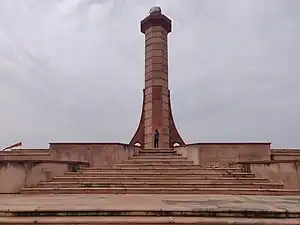The Mangarh massacre occurred on 17 November 1913, when British and Indian troops attacked the stronghold of Govindgiri at the end of the Bhil Revolt.[1] It occurred on a hillock in the Mangarh Hills of Rajasthan. There are no accurate figures for the number of Bhil who were killed, but estimates range from "several Bhils died"[2] to the oral tradition that 1,500 tribals were killed.[3]
Background
Govindgiri was a social and religious reformer among the tribes (adivasi) of the Rajasthan and Gujarat areas of India.[4] He had run afoul of the local princely state rulers, notably Sunth, Banswara, Idar, and Dungarpur because of his critique of the Indian hierarchy and its exploitation of the adivasi, and the subsequent social disruptions by his followers that his doctrines caused.[1][4]
October–November 1913
Fleeing from an attempt by the ruler of Idar State to capture Govindgiri, Govindgiri and his adherents formed a defensive position on a hillock in the Mangarh Hills on the borders of the princely states of Banswara and Sunth.[2] On 31 October, some of his followers attacked the police outpost at Gadhran, looted it, killed one police constable and took another officer captive.[5] On 1 November, some of his followers unsuccessfully attacked the Parbatgadh fort in Sunth.[5] Meanwhile, bands of Bhil from the Mangarh Hills were attacking and looting local villages in both Sunth and Banswara.[2][5] Police were dispatched from both Banswara and Sunth to end the assembly, but negotiations failed.[5] So the rulers sought a military solution.[2][5] Units of Imperial Service Troops and the Mewar Bhil Corps besieged the hillock.[2] On 12 November 1913, Govindgiri and his deputy Punja Pargi (aka Punja Dhirji) sent a delegation to the British with their list of grievances, "but negotiations did not take place."[2]However, the commanding officer did give the delegation an ultimatum: Disband before 15 November. The Bhil stood firm and stayed. On 17 November 1913, the Indian and British forces attacked the Bhil defensive works, and captured Govindgiri and his deputy Punja Pargi[5] as well as 900 prisoners.[2]
Mangarh Dham

A monument was built on the hillock honouring the victims of the massacre.[6] In November 2022, it was declared a national monument.[7] In 2017, plans were begun to put a Tribal Freedom Struggle Museum there as well.[8] The museum was completed in 2022.[9]
Name and legacy
At the time of the Mangarh massacre little note was made of it,[6][1][10] in part because the victims were mere tribesmen, and details only appeared in local or regional documents.[2] However as Indian nationalism grew, so did interest in past injustices,[11] with the 1919 Jallianwala Bagh massacre taking center stage.[12] As a result, the Mangarh massacre was often referred to as the Adivasi Jallianwala Bagh[10] or the Jallianwala Bagh of Vagad[8] in reference to the better known one.
References
- 1 2 3 Vashishtha, Vijay Kumar (1991). "The Bhil Revolt of 1913 Under Guru Govindgiri Among the Bhils of Southern Rajasthan and its Impact". Proceedings of the Indian History Congress. 52: 522–527. JSTOR 44142651.
- 1 2 3 4 5 6 7 8 Sehgal, K. K. (1974). Rajasthan District Gazetteers: Banswara (PDF). Jaipur: Directorate, District Gazetteers. p. 34.
- ↑ Mahurkar, Uday (30 November 1999). "Descendants of Mangad massacare seek recognition for past tragedy". India Today.
- 1 2 Natani, Prakash Narayan (1998). राजस्थान का स्वाधीनता आंदोलन [Independence Movement of Rajasthan] (in Hindi). Jaipur: Granth Vikas. pp. 54–58. OCLC 40163902.
- 1 2 3 4 5 6 Parmar, Ladhabhai Harji (1922). The Rewakantha Directory. Rajkot: Parmar Press. p. 25–26.
- 1 2 Meena, Mohrsinh (15 August 2021). માનગઢ : ગુજરાતની સરહદે થયેલો એ નરસંહાર જે 'જલિયાંવાલા બાગ'થી પણ મોટો ગણાય છે [Mangarh: The genocide on the border of Gujarat which is considered bigger than 'Jallianwala Bagh'] (in Gujarati). BBC News. Archived from the original on 15 August 2021.
- ↑ Priyanka (4 November 2022). "PM Modi Declared Mangarh Dham National Monument". Current Affairs Section of Adda247. Archived from the original on 4 November 2022.
- 1 2 बांसवाड़ा के मानगढ़ धाम में राष्ट्रीय जनजाति संग्रहालय के लिए भूमि प्रत्यावर्तन को मंजूरी [Approval for repatriation of land for National Tribal Museum at Mangarh Dham in Banswara]. Khaskhabar (in Hindi). 17 October 2017. Archived from the original on 28 October 2017.
- ↑ "National Tribal Freedom Struggle Museum Mangadham, Banswara". Rajasthan Heritage Protection Promotion Authority. 11 July 2022. Archived from the original on 16 July 2022.
- 1 2 "Adivasi Jallianwala Bagh: The Mangarh massacre of 1913 that PM Modi spoke of in Rajasthan". Firstpost. 2 November 2022. Archived from the original on 8 November 2022.
- ↑ Patnaik, Prabhat (1993). "Fascism of our times". Social Scientist. 21 (3/4): 69–77. doi:10.2307/3517631. JSTOR 3517631.
- ↑ Ramachandran, Rajesh, ed. (2019). Martyrdom to Freedom: 100 Years of Jallianwala Bagh. New Delhi: Rupa for the Tribune Trust. ISBN 978-93-5333-461-1.
23°21′01″N 73°59′12.5″E / 23.35028°N 73.986806°E